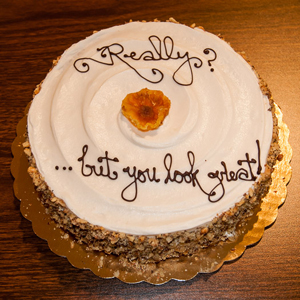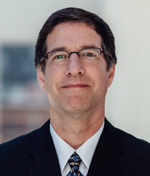“Really? … But You Look Great!”

In his AgeWise article last month, Ken wrote about how humor and gratitude helped him be more resilient during two back-to-back cancer diagnoses and treatments three years ago. He also wrote about how creating a blog and writing about his experiences allowed him a means of fighting back against the stresses of disease and treatments. This month, Ken touches upon his strategies for living with active Crohn’s disease, a chronic and mostly “invisible” illness.
After successfully concluding my cancer treatments in 2013, I was looking forward to closing this long and intense chapter of my life. As I was also closing in on a milestone birthday, my beloved wife and some friends arranged a big celebration event for me. Family, friends, and even my medical team gathered for a grand celebration to mark these two events as well as raise funds for a local cancer charity’s patient assistance fund.
Soon after the celebration, I turned my attention to resuming a “normal” life and returning to work; however, a looming question attempted to cloud my horizon: How was my Crohn’s disease going to impact my life after cancer?
Almost none of the effective medications I previously used were now available to me because their use came with a very high risks of cancer occurrence. Lacking good treatment options for Crohn’s was now a big concern, and only time would tell how things would play out.
I also wondered about the future of my blog. Looking at these two cancer ordeals through the lens of a storyteller, both followed classic storytelling arcs. Each started with rising action—my diagnosis; then crisis—treatments and their related ups and downs; followed by climax—my PET scans, which showed no active disease; then falling action—post-treatment celebrations; and finally, resolution—returning to normal daily activities and work. After two intense years of ups and downs, everybody was so pleased when I wrote about the results of my concluding PET scans that you could almost hear the collective sighs of relief.
 I thought about continuing my writing, seeing as it helped me maintain my resilience during chemotherapy and radiation treatments. But it was becoming clear to me, both as a fledgling writer and as a patient, that living with untreated Crohn’s disease was very different “story” than fighting cancer. The arc of this story was not going to rise and then fall to conclusion. There was rising action and a crisis, but since it was a chronic disease, there was not going to be a climax, falling action, or resolution—elements that normally conclude a story. Barring the need for emergency surgery or the discovery of a new miracle drug, the story arc for living with a chronic, active illness like Crohn’s disease was essentially flat and seemingly unending.
I thought about continuing my writing, seeing as it helped me maintain my resilience during chemotherapy and radiation treatments. But it was becoming clear to me, both as a fledgling writer and as a patient, that living with untreated Crohn’s disease was very different “story” than fighting cancer. The arc of this story was not going to rise and then fall to conclusion. There was rising action and a crisis, but since it was a chronic disease, there was not going to be a climax, falling action, or resolution—elements that normally conclude a story. Barring the need for emergency surgery or the discovery of a new miracle drug, the story arc for living with a chronic, active illness like Crohn’s disease was essentially flat and seemingly unending.
After mulling over my options, I quickly realized that I was back again fighting a chronic illness that I had been battling for over 20 years. What could I possibly say in a blog other than it was continuing to wreak daily havoc in my life? Spending several exhausting and often quite painful hours almost every day in or near a bathroom was a topic that few people want to read about, let alone discuss. My family and friends cared about me, but subjecting all of us to regular posts in this vein seemed to be asking a bit much of them, as well as me. I needed to maintain my resilience, not tear away at it.
I may have made that choice three years ago not to regularly write about my Crohn’s disease to help me cope with it, but I still needed ways to maintain my resilience. Since then, I have continued to tap into the humor and gratitude that I talked about last month, albeit now a bit more privately. They have helped me maintain my sanity as I am routinely greeted by family, friends and acquaintances with some variation of being told that “you look great.”
These are warm, loving, and sincere words, which I am always grateful to receive; however, too often, the truth is that I feel nowhere near as good as I look. My outward appearance may look good, but the inside of my body is an utter mess many days. I am typically anemic and exhausted, often in pain, lacking in sleep, and frequently functioning on a liquids-only diet.
My wife and I often joke that I am slowly becoming the living embodiment of Billy Crystal’s famous Fernando’s Hideaway quote on Saturday Night Live: “It is better to look good than to feel good.”
Please don’t misunderstand me as I am truly happy that I look good, and am sincerely grateful for the care and concern of others. But I am also fighting an invisible battle with a disease inside my body, and regularly hearing that I look good when I don’t feel it is often very frustrating. A healthy dose of internal humor and gratitude usually keeps matters in check and, more importantly, reminds me that I am more fortunate than many others who have travelled a similar path, including several close friends and colleagues.
I would be remiss in closing this article without admitting that humor and gratitude often need some reinforcements. Acceptance and accommodation are now playing larger roles in my life. As much as I want to believe that feeling resilient permits me to “power through” each day, the reality is that I need to be more strategic and flexible with my time and energy. I try to be more aware of where my limits actually are, versus where I often envision them to be. And I also remind myself that there is a difference between an optimum pace and maximum one.
I freely admit that it’s not always easy to make these adjustments, especially when many in our society believe the only pace in life is maximum, and that “it is better to look good than to feel good.” For some this may be true, but then I remember that many of my life’s most enjoyable moments—and best photographic opportunities—have taken place while journeying down backcountry roads, almost always at an unhurried pace.
Crohn’s disease, like cancer, may have dragged me into its world, but I know that there are still many things in life that I enjoy, just at a less hurried pace these days. And so the journey continues!
 Contributor Ken Astrein is a Senior Community Development Specialist with the Seattle Human Services Department. He has focused his 25+ years of work at the City of Seattle on developing partnerships with human service agencies to build places where communities can gather and families and individuals can receive essential services and support to better succeed in life.
Contributor Ken Astrein is a Senior Community Development Specialist with the Seattle Human Services Department. He has focused his 25+ years of work at the City of Seattle on developing partnerships with human service agencies to build places where communities can gather and families and individuals can receive essential services and support to better succeed in life.
Ken also contributed both of the photos above—Sunset Pioneer Highway, which he took in 2008, and his post-treatment celebration cake, taken in 2012.
Ken’s article, How Can I Be Happy Under the Circumstances?, appeared in the June 2016 issue of AgeWise King County.
![AgeWise King County [logo]](https://www.agewisekingcounty.org/wp-content/themes/agewisekingcounty/images/logo.png)